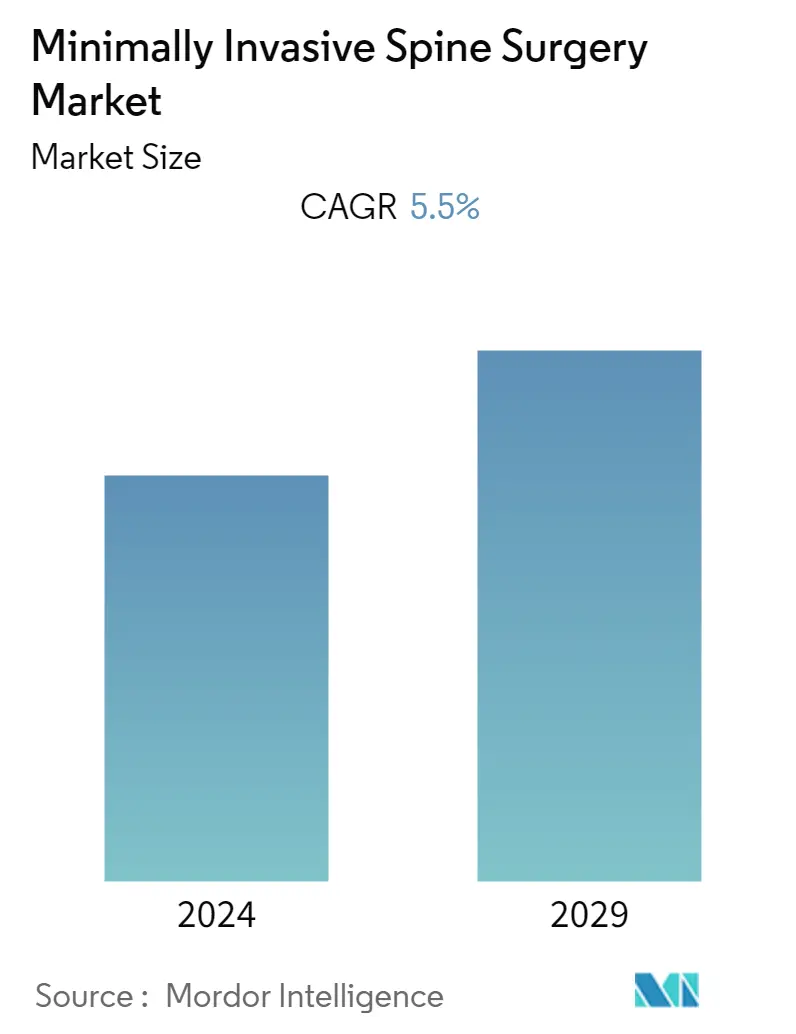Market Size of Minimally Invasive Spine Surgery Industry

| Study Period | 2021 - 2029 |
| Base Year For Estimation | 2023 |
| CAGR | 5.50 % |
| Fastest Growing Market | Asia-Pacific |
| Largest Market | North America |
| Market Concentration | Low |
Major Players
*Disclaimer: Major Players sorted in no particular order |
Minimally Invasive Spine Surgery Market Analysis
The minimally invasive spine surgery market is expected to register a CAGR of 5.5% over the forecast period.
- COVID-19 significantly impacted the minimally invasive spinal surgery market due to the cancellations of elective spine surgeries worldwide in the initial phase of the pandemic. Urgent spine surgeries were performed during the later phase of the pandemic. For instance, an article published in Acta Ortopedica Brasileira journal in July 2022 indicated that urgent surgeries were performed on 60.81% of patients during the later phase of COVID-19 in a tertiary hospital in Latin America. Hence, as the number of COVID-19 cases declined, the market regained its pre-pandemic level in terms of demand for spinal surgery devices.
- Additionally, the increase in incidences of spinal disorders, the rising number of ambulatory surgical centers, and the growing geriatric and obese population were the major driving factors of minimally invasive spine surgeries that drove the growth of the studied market over the forecast period.
- Furthermore, the growing geriatric population boosts the demand for inimally invasive spine surgery, accelerating market growth. For instance, according to Statpearls article updated in July 2022, spinal stenosis is a common condition among the elderly population. The same source indicated that 1 in 1000 people over 65 and 5 in 1000 people over 50 are at an increased risk of developing spinal stenosis. Thus, the geriatric population is at high risk of spinal diseases and hence is estimated to propel the market growth during the forecast period.
- Additionally, the advancements in technology and increasing product approvals, along with partnerships and acquisitions by key players, are helping in the market growth. For instance, in June 2022, Xenco Medical launched its Multilevel CerviKit, a single-use cervical spine implant for cervical spine procedures. It can be used in the ambulatory surgery center setting. Such developments are projected to propel the market growth during the forecast period.
- The advancements in minimally invasive devices are a major driver for its adoption across the globe. Robot-assisted surgery is becoming a fast-moving technology that enhances the accuracy of complex surgeries and reduces patient trauma. For instance, in December 2022, BLK-Max Hospital in India installed an advanced integrated robotic system for spine surgery. The robotic system deploys artificial intelligence (AI) to visualize spinal anatomy during complex surgeries. Therefore, due to continual advancements in robot-assisted surgical systems, the market is expected to grow during the forecast period.
- However, the stringent regulatory framework and high costs of surgical procedures are likely to impede the market growth.
Minimally Invasive Spine Surgery Industry Segmentation
Minimally invasive spine surgery (MISS) is a type of surgery performed on the spine's bones. This surgery generally uses smaller incisions than traditional surgery and often causes less harm to nearby muscles and other tissues. This minimally invasive surgery can lead to less pain and faster recovery after surgery.
The minimally invasive spine surgery market is segmented by product type (implants & instrumentation and biomaterials), application (fusion surgery and non-fusion surgery), treatment (lumbar disc herniation, thoracic disc herniation, spinal stenosis, degenerative spinal disease, and other treatments), and geography (North America, Europe, Asia-Pacific, Middle East, and Africa, South America). The market report also covers the estimated market sizes and trends for 17 different countries across major regions globally.
The report offers the value (in USD) for the above segments.
| By Product Type | |
| Implants & instrumentation | |
| Biomaterials |
| By Application | |
| Fusion Surgery | |
| Non-fusion Surgery |
| By Treatment | |
| Lumbar Disc Herniation | |
| Thoracic Disc Herniation | |
| Spinal Stenosis | |
| Degenerative Spinal Disease | |
| Other Treatments |
| Geography | ||||||||
| ||||||||
| ||||||||
| ||||||||
| ||||||||
|
Minimally Invasive Spine Surgery Market Size Summary
The minimally invasive spine surgery market is poised for steady growth, driven by an increasing prevalence of spinal disorders and advancements in surgical technologies. The market experienced a temporary setback due to the COVID-19 pandemic, which led to the postponement of elective surgeries. However, the demand for spinal surgery devices rebounded as the pandemic's impact waned. Key factors propelling market expansion include the rising geriatric and obese populations, which are more susceptible to spinal conditions, and the proliferation of ambulatory surgical centers. Technological innovations, such as robot-assisted surgeries and the development of advanced surgical devices, are further enhancing the precision and efficiency of spine surgeries, thereby boosting market growth. Despite these positive trends, challenges such as stringent regulatory requirements and high procedural costs may hinder market progress.
The market is characterized by strategic initiatives from key players, including product launches, partnerships, and collaborations, which are expected to drive growth in the biomaterials segment. Innovations in biomaterials, such as the development of biocompatible materials for spinal implants, are contributing to the market's expansion. North America is anticipated to witness significant growth due to the high incidence of spine disorders and ongoing technological advancements in spine surgery devices. The competitive landscape is marked by active engagement from major companies in product development and strategic alliances to meet the growing global demand. These dynamics, coupled with the increasing adoption of minimally invasive techniques, are expected to sustain the market's growth trajectory over the forecast period.
Minimally Invasive Spine Surgery Market Size - Table of Contents
-
1. MARKET DYNAMICS
-
1.1 Market Overview
-
1.2 Market Drivers
-
1.2.1 Technological Advancements in Surgical Equipment and Increasing Demand for Minimally Invasive Surgeries
-
1.2.2 Increase in Incidences of Spinal Disorders
-
1.2.3 Growing Geriatric and Obese Population
-
-
1.3 Market Restraints
-
1.3.1 Stringent Regulatory Framework
-
1.3.2 High Costs of Surgical Procedures
-
-
1.4 Porter's Five Forces Analysis
-
1.4.1 Threat of New Entrants
-
1.4.2 Bargaining Power of Buyers/Consumers
-
1.4.3 Bargaining Power of Suppliers
-
1.4.4 Threat of Substitute Products
-
1.4.5 Intensity of Competitive Rivalry
-
-
-
2. MARKET SEGMENTATION (Market Size by Value - USD)
-
2.1 By Product Type
-
2.1.1 Implants & instrumentation
-
2.1.2 Biomaterials
-
-
2.2 By Application
-
2.2.1 Fusion Surgery
-
2.2.2 Non-fusion Surgery
-
-
2.3 By Treatment
-
2.3.1 Lumbar Disc Herniation
-
2.3.2 Thoracic Disc Herniation
-
2.3.3 Spinal Stenosis
-
2.3.4 Degenerative Spinal Disease
-
2.3.5 Other Treatments
-
-
2.4 Geography
-
2.4.1 North America
-
2.4.1.1 United States
-
2.4.1.2 Canada
-
2.4.1.3 Mexico
-
-
2.4.2 Europe
-
2.4.2.1 Germany
-
2.4.2.2 United Kingdom
-
2.4.2.3 France
-
2.4.2.4 Italy
-
2.4.2.5 Spain
-
2.4.2.6 Rest of Europe
-
-
2.4.3 Asia-Pacific
-
2.4.3.1 China
-
2.4.3.2 Japan
-
2.4.3.3 India
-
2.4.3.4 Australia
-
2.4.3.5 South Korea
-
2.4.3.6 Rest of Asia-Pacific
-
-
2.4.4 Middle-East and Africa
-
2.4.4.1 GCC
-
2.4.4.2 South Africa
-
2.4.4.3 Rest of Middle-East and Africa
-
-
2.4.5 South America
-
2.4.5.1 Brazil
-
2.4.5.2 Argentina
-
2.4.5.3 Rest of South America
-
-
-
Minimally Invasive Spine Surgery Market Size FAQs
What is the current Global Minimally Invasive Spine Surgery Market size?
The Global Minimally Invasive Spine Surgery Market is projected to register a CAGR of 5.5% during the forecast period (2024-2029)
Who are the key players in Global Minimally Invasive Spine Surgery Market?
Medtronic, Johnson & Johnson (DePuy Synthes), Boston Scientific, Zimmer Biomet and Aesculap, Inc. are the major companies operating in the Global Minimally Invasive Spine Surgery Market.

